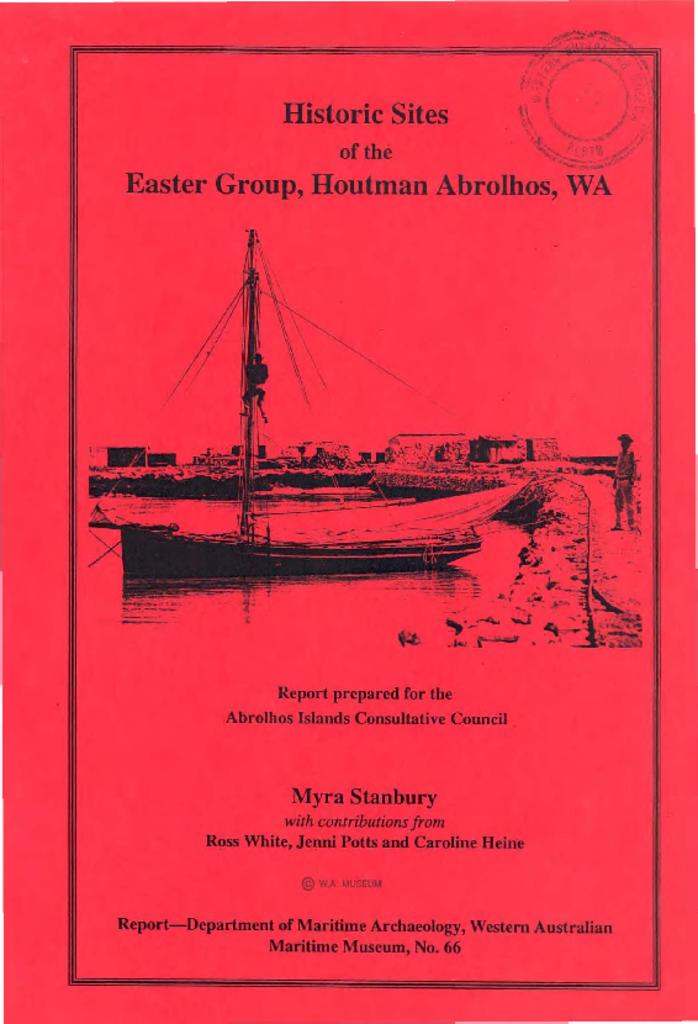Historic Sites of the Easter Group, Houtman Abrolhos, WA
Author/s M. Stanbury
Year of publication 1993
Report Number: 66
Introduction
The islands of the Houtman Abrolhos have connections with the earliest periods of European history in Australia. During the colonial period, guano mining occurred on several islands at the Abrolhos, initially as a smalI-scale activity associated with fishing ventures and later as a more organised industry.
In the 1970s, during archaeological investigations of the wreck of the Dutch East Indiaman Zeewijk (1727) in the Pelsaert Group, the Western Australian Maritime Museum identified several islands which had been signifIcantly disturbed by the effects of guano and rock phosphate mining, and which had remains of the infrastructure associated with the exploitation of these resources.
The archaeology, geology and history of this extractive industry as it pertained to the Pelsaert Group of islands was investigated and compiled into written and photographic reports (Stanbury, 1979 and 1982; Stanbury & Brown, 1979). In 1988, a report (Green & Stanbury, 1988) including reference to these sites was presented as a submission to the Abrolhos !sIands Task Force for consideration in the future planning strategy and management of the Abrolhos Islands. Although archival research had produced information relating to Rat Island in the Easter Group and its significance in the guano industry, field investigations of these islands had not been undertaken.
Section 2.2 of the Task Force Planning Strategy recognises the bislnry of the Abrolhos Islands (including guano mining) as comprising part of the 'Social Environment' of the Houtman Abrolhos (Abrolhos Islands Task Force(AlTF), 1988:8--9). Initial 'Planning Implications' pertaining to guano mining recognised that:
2. Guano mining has disturbed areas on some islands. These areas and the associated infrastructure that remain have some 'historic interest (ATIF, 1988:9).
Considering the 'Key issues and strategies' pertaining in the Abrolhos Islands the Task Force emphasised that
Through the fishing industry [the Islands] provide one of the most important economic resources in the Mid West Region. The islands are also the basis of a small but developing tourism and recreation industry. The status of the area should recognise these values, and emphasise and secure the basis of these industries.
[unreadable text] Significantly disturbed by the effects of guano and rock phosphate mining, and which had remains of the infrastructure associated with the exploitation of these resources. The archaeology, geology and history of this extractive industry as it pertained to the Pelsaert Group of islands was investigated and compiled into written and phonographic reports (Stanbury, 1979 and 1982; Stanbury & Brown, 1979). In 1988 a report (Green & Stanbury, 1988) including reference to these sites was presented as a submission to the Abrolhos IsIands Task Force for consideration in the future planning strategy and management of the Abrolhos Islands. Although archival research had produced information relating to Rat Island in the Easter Group and its significance in the guano industry, field investigations of these islands bad not been undertaken.
With respect to 'Areas of Historic Significance' (AITF,1988, 3.2.3:22), conservation issues are identified as:
Protect and Management
- Management of historic sites .
- Identiflcation of historic values.
- Access to land and wreck sites.
- Promotion and interpretation of sites.
As part of the conservation strategy for these areas the Task Force proposed that site management plan be prepared for historic sites on nominated islands (AITF, 1988,3.2.3:22) and that 'Further research into archaeological and historical sites on and around the islands ... be encouraged' .
This project has been undertaken on behalf of the Abrolhos Islands Consultative Council (AlCC). If the islands are to be developed for tourism and recreation, there is a need for cultural sites to be identified and site management plans to be prepared in order to ensure adequate protection of the sites. Given the financial and time constraints of this project, and the complex issues concerning the management of the Houtman Abrolhos, this report is not intended as a final Conservation Plan for historic sites on Rat Island and associated islands in the Easter Group. Rather, it is a preliminary compilation of data and site evaluations which may be used in the development of a more comprehensive management strategy.
